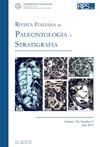NEW ACROPOMATIFORM FOSSILS FROM THE UPPER KUEICHULIN FORMATION (LOWER PLIOCENE), NORTHERN TAIWAN
IF 1.6
3区 地球科学
Q2 GEOLOGY
引用次数: 0
Abstract
The Indo-West Pacific is home to a diverse array of modern fish species, and the study of their fossils can provide valuable insights into the origins and evolution of this biodiversity. This report presents rare remains of five individuals of acropomatiform fish, including a semi-articulated skeleton, recovered from the Upper Kueichulin Formation (Lower Pliocene) in northern Taiwan. The fossils are preserved in the form of nodules discovered at the locality known for abundant marine crustaceans and echinoderms. These specimens can be assigned to the family Stereolepididae, based on morphology of the opercle with the presence of two spines, a preopercle characterized by serrations on the posterior margin and denticulations on the ventral margin, and a distinctive skull architecture. Differences in skull morphology distinguish these specimens from other species within the genus and thus are described as Stereolepis arcanum n. sp. Significantly, the species represents the oldest known record of the family globally and stands as the second known fossil representative. This discovery not only enhances our understanding of the palaeobiodiversity of fish fauna in the Indo-West Pacific during the Neogene, but also highlights the importance of further research efforts in this area.台灣北部龜丘林上層(下新世)出土的新尖頂化石
印度-西太平洋是多种现代鱼类的家园,对其化石的研究可为了解这种生物多样性的起源和演化提供宝贵的信息。本报告介绍了从台湾北部上古魁楚林地层(下新世)发掘出的罕见的五条尖嘴鱼类化石,包括一具半关节骨架。这些化石以结核形式保存,发现于以盛产海洋甲壳类和棘皮动物而闻名的地点。这些标本可归属于立体栉水母科(Stereolepididae),其依据是厣的形态,厣上有两根棘刺,前厣后缘有锯齿,腹缘有齿状突起,以及独特的头骨结构。头骨形态上的差异将这些标本与该属的其他物种区分开来,因此被描述为 Stereolepis arcanum n. sp.这一发现不仅加深了我们对印度-西太平洋新近纪鱼类动物古生物多样性的了解,而且突出了在这一领域开展进一步研究的重要性。
本文章由计算机程序翻译,如有差异,请以英文原文为准。
求助全文
约1分钟内获得全文
求助全文
来源期刊
CiteScore
3.60
自引率
4.30%
发文量
28
审稿时长
>12 weeks
期刊介绍:
The Rivista Italiana di Paleontologia e Stratigrafia was founded in 1895. It publishes original papers dealing with all fields of paleontology and of stratigraphy, from Italy and the Mediterranean to the Tethys, as well across the globe from China to North America.

 求助内容:
求助内容: 应助结果提醒方式:
应助结果提醒方式:


